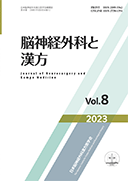Current issue
Journal of Neurosurgery and Kampo Medicine
Displaying 1-11 of 11 articles from this issue
- |<
- <
- 1
- >
- >|
Original Article
-
Article type: research-article
2023Volume 8Issue 1 Pages 1-9
Published: August 30, 2023
Released on J-STAGE: September 30, 2023
Download PDF (2449K) -
Article type: research-article
2023Volume 8Issue 1 Pages 10-15
Published: August 30, 2023
Released on J-STAGE: September 30, 2023
Download PDF (4450K) -
Article type: research-article
2023Volume 8Issue 1 Pages 16-20
Published: August 30, 2023
Released on J-STAGE: September 30, 2023
Download PDF (1022K) -
Article type: research-article
2023Volume 8Issue 1 Pages 21-24
Published: August 30, 2023
Released on J-STAGE: September 30, 2023
Download PDF (987K)
Case Report
-
Article type: case-report
2023Volume 8Issue 1 Pages 25-28
Published: August 30, 2023
Released on J-STAGE: September 30, 2023
Download PDF (1364K) -
Article type: case-report
2023Volume 8Issue 1 Pages 29-32
Published: August 30, 2023
Released on J-STAGE: September 30, 2023
Download PDF (1387K) -
Article type: case-report
2023Volume 8Issue 1 Pages 33-38
Published: August 30, 2023
Released on J-STAGE: September 30, 2023
Download PDF (1569K) -
Article type: case-report
2023Volume 8Issue 1 Pages 39-42
Published: August 30, 2023
Released on J-STAGE: September 30, 2023
Download PDF (1219K)
Topics
-
Article type: topics
2023Volume 8Issue 1 Pages 43-46
Published: March 30, 2023
Released on J-STAGE: September 30, 2023
Download PDF (990K) -
Article type: topics
2023Volume 8Issue 1 Pages 47-50
Published: August 30, 2023
Released on J-STAGE: September 30, 2023
Download PDF (980K)
Editorial note
-
Article type: educational lecture
2023Volume 8Issue 1 Pages 51-
Published: August 30, 2023
Released on J-STAGE: September 30, 2023
Download PDF (815K)
- |<
- <
- 1
- >
- >|
